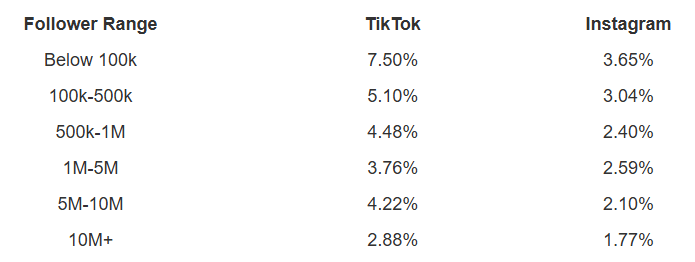In 2025, TikTok continues to lead the pack in social media engagement, with average rates hovering between 2.5% and 7.5% depending on audience size—making it the most interactive platform today. Instagram holds steady in second place, showing engagement between 1.77% and 3.65%, despite some sources noting a dip compared to previous years. Both platforms still outperform others like Facebook and X, which see much lower interaction rates around 0.15%
TikTok or Instagram, Which Would You Use?
27th May, 2020 |
Social media is an important part of many people’s lives, you either love it or loathe it and wherever you stand there seems to be no avoiding it. As a marketer it’s vital to keep up-to-date on the rapidly evolving digital landscape. In today’s world, one would not be remiss in suggesting that TikTok rivals Instagram’s popularity. But what exactly differs between the 2 social media apps and if you were a marketer, which would you use? Tiktok or Instagram?
A video platform allowing users to watch clips, and create up to 60 seconds of footage mainly based around dancing, comedy skits, and lip-syncing.
- Monthly Active Users: Approximately 2.5 billion globally, marking significant growth from previous years.
-
-
Age:
-
13–17 years: 20%
-
18–24 years: 36%
-
25–34 years: 25%
-
35–44 years: 12%
-
45+ years: 7%
-
-
Gender: Approximately 55% female and 45% male users.
-
- Average Daily Usage: Users spend an average of 95 minutes per day on the platform, reflecting its highly engaging content and algorithm.
- Content Focus: Short-form videos encompassing entertainment, comedy, educational content, and lip-syncing, with features like duets and challenges enhancing user interaction.
A platform for sharing pictures, you can also upload videos on Instagram using IGTV as well as film short clips on IG stories.
-
Monthly Active Users: Approximately 2.11 billion globally.
- User Demographics
-
Age:
-
18–24 years: 31.3%
-
25–34 years: 31%
-
35–44 years: 16%
-
45–54 years: 11%
-
55+ years: 10%
-
-
Gender: Approximately 49.4% female and 50.6% male users.
-
-
Average Daily Usage: Users spend an average of 32 minutes per day on the platform.
-
Content Focus: A photo-sharing platform, Instagram also supports videos through Reels, IGTV, and Stories, catering to a wide range of content creators and audiences.
TikTok vs. Instagram Engagement Rate

Compared to Instagram—a platform many marketers are comfortable with thanks to its tried and tested campaign formats and measurable results—TikTok has had a steeper learning curve. But that’s changing fast. While some brands were initially hesitant due to unfamiliarity or concerns about ROI, TikTok’s sky-high engagement rates are making it harder to ignore. In fact, nano influencers on TikTok see average engagement rates of over 15%, compared to Instagram’s 4.2%. Even at the mega influencer level, TikTok still pulls ahead significantly.
Although TikTok was once known for its younger user base, that’s also evolving. While it still strongly appeals to Gen Z, over 60% of its audience is now aged 18–34. That makes it a valuable platform for brands aiming to capture emerging spending power—not just teenage trends. On the other hand, Instagram remains a solid choice for targeting a slightly older, more established audience with higher disposable income and a preference for polished content.
That said, the smartest brands are finding ways to integrate both platforms into their marketing mix. TikTok is ideal for launching creative campaigns—like hashtag challenges or trend-driven collabs with creators—to boost visibility and follower growth. Instagram, meanwhile, continues to be the space for refined storytelling, strong visuals, and ongoing brand engagement.
All in all, Instagram still stands out as the polished, professional platform, but TikTok’s explosive growth and unmatched engagement can’t be ignored. If brands want to stay relevant—especially with Gen Z and younger millennials—being present on TikTok isn’t just a nice-to-have anymore, it’s essential. The key is not choosing one over the other, but knowing how to use both to your brand’s advantage.




